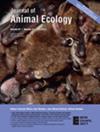Fruits important for network cohesiveness may not be the same as those key for bird diets
IF 3.7
1区 环境科学与生态学
Q1 ECOLOGY
引用次数: 0
Abstract




对网络凝聚力很重要的水果可能与鸟类饮食的关键水果不同。
了解共生伙伴的灭绝如何影响物种及其在群落中的功能作用是生态学的一个基本问题。这些变化影响了相互作用网络的结构,但它们如何影响相互作用的结果,如动物的营养资源供应,目前尚不清楚。在这里,我们用来自阿根廷Yungas森林的六个群落的植物-鸟类相互作用的综合数据集拟合了一个群落水平的frugivory模型。然后,我们预测了植物损失前后鸟类的水果选择,允许重新布线和量化网络结构的变化和果食动物的相互作用结果(即饮食的营养成分)。使用这种建模方法,我们测试了对网络凝聚力重要的植物是否也维持鸟类的营养摄入。此外,我们将网络和鸟类饮食的变化与植物的总消耗率及其果实的营养含量联系起来。最后,我们评估了食果动物在失去伴侣(即重新连接)后利用新资源的能力如何保护它们免受饮食营养变化的影响。我们的研究结果表明,维持网络凝聚力的植物物种不同于那些决定鸟类饮食营养特征的植物物种。大多数营养丰富的水果和那些在群落内提供独特营养组合的水果是鸟类营养摄入的关键,但它们经常被网络指标所忽视。此外,我们表明,在失去伴侣后更容易开发新资源的食果动物,其饮食的平均营养含量会发生重大变化。我们的模型表明,网络结构的关键物种可能与鸟类的饮食不同。因此,在仅根据植物物种在网络中的位置推断其丧失的功能后果时,我们应该保持谨慎。此外,我们发现重新布线会影响鸟类的营养,这可能会带来一些代价。总的来说,我们的研究揭示了物种灭绝、网络结构和相互作用结果之间的机制联系,这挑战了一些经常在节俭研究中做出的假设。
本文章由计算机程序翻译,如有差异,请以英文原文为准。
求助全文
约1分钟内获得全文
求助全文
来源期刊

Journal of Animal Ecology
环境科学-动物学
CiteScore
9.10
自引率
4.20%
发文量
188
审稿时长
3 months
期刊介绍:
Journal of Animal Ecology publishes the best original research on all aspects of animal ecology, ranging from the molecular to the ecosystem level. These may be field, laboratory and theoretical studies utilising terrestrial, freshwater or marine systems.
 求助内容:
求助内容: 应助结果提醒方式:
应助结果提醒方式:


